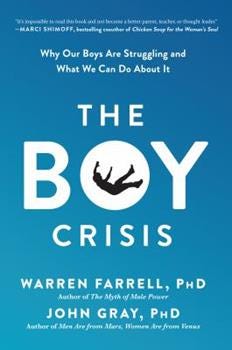This is a brief excerpt (pgs. 119-122) from Warren Farrell’s The Boy Crisis. Here’s a link to the Boy Crisis on Amazon and here is Warren’s web site
Let Me Count the Ways

Appendix B lists some fifty-five ways that children benefit from significant father involvement—or put another way, fifty-five ways in which dad-deprived children are more likely to suffer. We’ve already seen a few ways (greater vulnerability to sexual abuse, to ISIS, and to gangs) and still others will be described in the context of when dads matter (see the section “When Does Dad Begin to Matter?” in the next chapter) or what dads do differently, (see “What Dads Do Differently”). Let’s start with fifteen that are more generally applicable to your son’s life.
1. School Achievement. A study of boys from similar backgrounds revealed that by the third grade, the boys whose fathers were present scored higher on every achievement test and received higher grades.[i]
2. The 3 Rs. The more involved dad is, the greater a boy’s increase in verbal intelligence,[ii] and the better both boys’ and girls’ math and quantitative abilities.[iii]
3. School Dropouts. The more years children spend with no or minimal father involvement, the fewer years of school they complete;[iv]71 percent of high school dropouts have minimal or no father involvement. Dad-deprived children are also more likely to skip school or be kicked out (expelled).[v]
4. Employment. While boys from two-parent homes are more likely than their sisters to be employed as young adults, boys who are dad deprived are more likely than their sisters to be unemployed.[vi] And when they are employed, dad-deprived boys are also less likely than their sisters to succeed as professionals.[vii]
5. Suicide. Living in a home without a dad is more highly correlated with suicide among children and teenagers than any other factor.[viii]
6. Drugs. Father involvement is at least five times more important in preventing drug use than closeness to parent, parental rules, parent trust or strictness, and is a stronger determining factor than the child’s gender, ethnicity, or social class.[ix]
7. Homelessness. Around 90 percent of runaway and homeless youths are from fatherless homes.[x]
8. Bullying. The American Psychological Association found in its review of 153 studies that father absence predicts the profile of both the bully and the bullied: poor self-esteem, poor grades, and poor social skills.[xi]
9. Victimization. Children between ten and seventeen living without their biological dad were more likely to be victims of child abuse, major violence, sexual assault, and domestic violence.[xii]
10. Violent crime. Every 1 percent increase in fatherlessness in a neighborhood predicts a 3 percent increase in adolescent violence.[xiii]
11. Rape. Among rapists who were specifically assessed as raping out of anger and rage, 80 percent came from father-absent homes.[xiv]
12. Poverty and Mobility. Children who were born poor and raised by both married parents had an 80 percent chance of moving to the middle class or above; conversely, children who were born into the middle class and raised without a married dad were almost four times as likely to end up considerably poorer.[xv]
13. Hypertension. Among black boys, hypertension is reduced by 46 percent when dads are significantly involved.[xvi]
14. Trust. The more contact children have with their dads, the more easily they make open, receptive, and trusting contact with new people in their lives.[xvii]
15. Empathy. The amount of time a father spends with a child is one of the strongest predictors of the child’s ability to empathize in adulthood.[xviii]
[i]Henry Biller, Paternal Deprivation: Family, School, Sexuality, and Society (Lexington, MA: Lexington Books, 1974).
[ii]N. Radin, “The Role of the Father in Cognitive, Academic, and Intellectual Development,” in The Role of the Father in Child Development, ed. M. E. Lamb (New York: John Wiley & Sons, 1981), 379–427; N. Radin, “The Influence of Fathers on Their Sons and Daughters,” Social Work in Education 8 (1986): 77–91;
N. Radin and G. Russell, “Increased Paternal Participation and Childhood Outcomes,” in Fatherhood and Family Policy, ed. M. E. Lamb and A. Sagi (Hillsdale, NJ: Lawrence Erlbaum, 1983), 191–218.
[iii] See H. S. Goldstein, “Fathers’ Absence and Cognitive Development of 12- to 17-Year-Olds,” Psychological Reports 51 (1982): 843–48. See also N. Radin, “Role of the Father”; N. Radin, “Influence of Fathers.”
[iv] Sheila Fitzgerald Krein and A. Beller, “Educational Attainment of Children from Single-Parent Families: Differences by Exposure, Gender, and Race,” Demography 25 (May 1988): 403–26.
[v] Edward Kruk, “The Vital Importance of Paternal Presence in Children’s Lives,” Psychology Today, May 23, 2012, http://www.psychologytoday.com/blog/co-parenting-after-divorce/201205/father-absence-father-deficit-father-hunger.
[vi] David Autor et al., “Family Disadvantage and the Gender Gap in Behavioral and Educational Outcomes,” (working paper no. 22267, National Bureau of Economic Research, May 2016), doi:10.3386/w22267. Specifically, “For young adults from married households, employment is higher among men than women at all parental income quintiles; for young adults from non-married households, male employment at age 30 is everywhere lower than among women.”
[vii] Kruk, “ Vital Importance of Paternal Presence.”
[viii] Carmen Noevi Velez and Patricia Cohen, “Suicidal Behavior and Ideation in a Community Sample of Children: Maternal and Youth Reports,” Journal of the American Academy of Child and Adolescent Psychiatry 273 (1988): 349–56.
[ix] The only factor more important than father involvement was the child’s age. Robert H. Coombs and John Landsverk, “Parenting Styles and Substance Use During Childhood and Adolescence,” Journal of Marriage and the Family 50 (May 1988): 479, table 4. The factors considered were age, sex, ethnicity, social class, closeness to parent, parent trust, parental rules, parent strictness, etc. Age accounted for about 17 percent of the variation in drug use among the youth in their sample; positive father sentiment (closeness) accounted for another 10 percent, and no other factor accounted for more than 2 percent.
[x] US Department of Justice, “What Can the Federal Government Do to Decrease Crime and Revitalize Communities?” Panel Papers, Office of Justice Programs, National Institute of Justice, 1998, 11 https://www.ncjrs.gov/pdffiles/172210.pdf.
[xi] APA, “Who Is Likely to Become a Bully, Victim or Both?” EurekaAlert!, July 8, 2010, http://www.eurekalert.org/pub_releases/2010-07/apa-wil070810.php.
[xii] Heather A. Turner, “The Effect of Lifetime Victimization on the Mental Health of Children and Adolescents,” Social Science & Medicine 62, no. 1 (January 2006): 13–27.
[xiii] Study employed data from the National Longitudinal Study of Adolescent Health; see Chris Knoester and Dana L Haynie, “Community Context, Social Integration into Family, and Youth Violence,” Journal of Marriage and Family 67, no. 3 (2005): 767–80, doi:10.1111/j.1741-3737.2005.00168.x.
[xiv]Raymond A. Knight and Robert A. Prentky, “The Developmental Antecedents of Adult Adaptions of Rapist Sub-types,” Criminal Justice and Behavior 14, no. 4 (1987): 413–14, doi:10.1177/0093854887014004001. Knight and Prentky labeled this type of rapist as one with “displaced anger.”
[xv] Richard V. Reeves, “Saving Horatio Alger: Equality, Opportunity, and the American Dream,” Brookings Institution, Brookings Essay, August 20, 2014. See video: http://www.brookings.edu/research/essays/2014/saving-horatio-alger.
[xvi] After adjustment for family history of hypertension, obesity, age, employment, smoking, diabetes, etc. See Todd Neale, “Two-Parent Homes Foster Lower BP in Black Males,” MedPage Today, December 2, 2013,http://www.medpagetoday.com/Cardiology/Hypertension/43212?xid=nl_mpt_DHE_2013-12-03.
[xvii] Mary Main and Donna R. Weston, “The Quality of the Toddler’s Relationship to Mother and to Father: Related to Conflict Behavior and the Readiness to Establish New Relationships,” Child Development 52, no. 3 (1981): 932–40, doi:10.2307/1129097.
[xviii] Richard Koestner, C. Franz, and J. Weinberger, “The Family Origins of Empathic Concern: A Twenty-Six-Year Longitudinal Study,” Journal of Personality and Social Psychology 58, no. 4 (April 1990): 709–17.
Tom Golden is the author or three books, Swallowed by a Snake: The Gift of the Masculine Side of Healing, The Way Men Heal, and Helping Mothers be Closer to Their Sons: UnderStanding the Unique World of Boys. Tom was the creator of the youtube channel Men Are Good , was in the Red Pill Movie, and served as the vice chairman of the Maryland Commission for Men’s Health. He has been a therapist in private practice for over 30 years.
